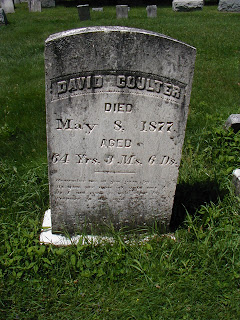The most popular source of gravestone epitaphs is, as would be expected, the Bible. Sometimes, the stone cites the Bible verse, but often it did not. The Bible quotes come from the King James version.
Fanny Taylor Coulter’s stone has a verse from Matthew: “Be ye also ready for in such an hour as ye think not the Son of man cometh.” Fanny, the wife of David Coulter, was 77 at her death in 1897. Helen Anderson Hamilton, the wife of Thomas Hamilton, was 60 at her death in 1868. Her stone has not one but two Bible verses. From Revelation: “And I heard a voice from heaven saying unto me, Write, Blessed are the dead which die in the Lord from henceforth: Yea, saith the Spirit, that they may rest from their labours; and their works do follow them.” From Luke: “Weep not for me but weep for yourselves.” When eight year old James K. Miller died in 1860, his grieving parents chose a verse from Job: “The eye of him that hath seen me shall see me no more: thine eyes are upon me, and I am not.”
The grave of New Kingston resident and Civil War fatality James C. Elliott has not only two bible verses but text from a hymn. The hymn text is a paraphrase from a hymn written by William Cullen Bryant for Abraham Lincoln’s funeral:
Thy task is done the bond are free
We never saw thy honored grave
Whose proudest moment shall be
The broken fetters of the slave
Since Elliott’s body was never brought home, the family made a change to the hymn. The second line in the original hymn was “We bear thee to an honored grave.”
Several other war fatalities include information about their death. William Henry Stott's stone explains that he was a member of Company E, 3rd NYS Volunteers. The stone further explained that Stott “fell in battle in defence of his Country at Chula Bridge on the Richmond & Danville Rail Road, Va. May 24th, 1861, aged 22 years 2 mo and 1 day.”
Clark G. Miller (1894-1918) was one of two Bovina fatalities in World War I buried in Bovina. His stone states that he was “KILLED IN DEFENCE OF PARIS, FRANCE.” James D. Calhoun (1889-1918) died later the same year. His stone gives information on his company and simply states “THE SUPREME SACRIFICE.”
Several epitaphs wax poetically. Jennie Miller was 31 at her death in 1870. On her headstone is a slight paraphrase of a poem by Lydia H. Sigourney, published in 1842:
She’s gone where no dark sin is cherished
Where no woes nor fears invade
Gone are youth first bud had perished
To a youth that ne’er can fade
Though not consistently, flowery epitaphs often appear on graves of those who died young, such as Jennie Miller. When James Bryden died in 1899, he was 21. The poem on his headstone is a standard one for memorial cards and headstones in that era:
A precious one from us has gone,
A voice we loved is stilled.
A place is vacant in our home,
Which never can be filled.
God in his wisdom has recalled,
The boon his love had given;
And though the body slumbers here,
The soul is safe in heaven.
The family of Robbie Laidlaw, who was 14 at his death in 1888, used a hymn written by Margaret Mackay in 1832:
Asleep, in Jesus blessed sleep,
From which none ever wakes to weep;
A calm and undisturbed repose,
Unbroken by the last of foes.
Not all epitaphs were on graves of those who died young. When John R. Thomson died in 1892, age 82, his family put the following on his stone:
Farewell dear Father sweet thy rest
Weary with years and worn with pain
Farewell till in some happy place
We shall behold thy face again.
Into the 20th century, most graves did not have epitaphs, but it’s a tradition that in Bovina cemeteries is making a comeback. When my cousin John LaFever died in 1995, his family put the following on his headstone:
His courage, his smile,
his enthusiasm for life
brought joy to the hearts
of those who have the
privilege of loving him.
I close with the headstone of someone especially close to me, my dear old Dad. My mom and dad loved the poem ‘High Flight.’ Written by John Gillespie Magee, a young pilot who was killed in a training accident when only 19, the poem is especially favored by pilots like my dad. Mom particularly wanted a phrase from that poem, along with an engraving of a small airplane, similar to those that Dad flew.
































